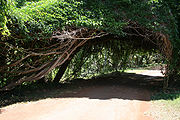
Entada gigas
Encyclopedia
Entada gigas, commonly known as the Cœur de la Mer or Sea Heart, is a species of flowering
liana
in the pea
family, Fabaceae
, that is native to Central America
, the Caribbean
, northern South America
, and Africa
. It is notable for having the family's largest seedpods, which measure 12 cm (4.7 in) across and can reach 2 m (6.6 ft) in length. Inside the pods are ten to fifteen seed
s, each of which have a diameter of 6 cm (2.4 in) and a thickness of 2 cm (0.78740157480315 in). The seeds contain a hollow cavity, which gives them buoyancy
. After being washed by rain into rivers and then the ocean, the seeds of E. gigas drift
long distances on ocean current
s. Seed buoyancy and vitality lasts at least two years.

Flowering plant
The flowering plants , also known as Angiospermae or Magnoliophyta, are the most diverse group of land plants. Angiosperms are seed-producing plants like the gymnosperms and can be distinguished from the gymnosperms by a series of synapomorphies...
liana
Liana
A liana is any of various long-stemmed, woody vines that are rooted in the soil at ground level and use trees, as well as other means of vertical support, to climb up to the canopy to get access to well-lit areas of the forest. Lianas are especially characteristic of tropical moist deciduous...
in the pea
Pea
A pea is most commonly the small spherical seed or the seed-pod of the pod fruit Pisum sativum. Each pod contains several peas. Peapods are botanically a fruit, since they contain seeds developed from the ovary of a flower. However, peas are considered to be a vegetable in cooking...
family, Fabaceae
Fabaceae
The Fabaceae or Leguminosae, commonly known as the legume, pea, or bean family, is a large and economically important family of flowering plants. The group is the third largest land plant family, behind only the Orchidaceae and Asteraceae, with 730 genera and over 19,400 species...
, that is native to Central America
Central America
Central America is the central geographic region of the Americas. It is the southernmost, isthmian portion of the North American continent, which connects with South America on the southeast. When considered part of the unified continental model, it is considered a subcontinent...
, the Caribbean
Caribbean
The Caribbean is a crescent-shaped group of islands more than 2,000 miles long separating the Gulf of Mexico and the Caribbean Sea, to the west and south, from the Atlantic Ocean, to the east and north...
, northern South America
South America
South America is a continent situated in the Western Hemisphere, mostly in the Southern Hemisphere, with a relatively small portion in the Northern Hemisphere. The continent is also considered a subcontinent of the Americas. It is bordered on the west by the Pacific Ocean and on the north and east...
, and Africa
Africa
Africa is the world's second largest and second most populous continent, after Asia. At about 30.2 million km² including adjacent islands, it covers 6% of the Earth's total surface area and 20.4% of the total land area...
. It is notable for having the family's largest seedpods, which measure 12 cm (4.7 in) across and can reach 2 m (6.6 ft) in length. Inside the pods are ten to fifteen seed
Seed
A seed is a small embryonic plant enclosed in a covering called the seed coat, usually with some stored food. It is the product of the ripened ovule of gymnosperm and angiosperm plants which occurs after fertilization and some growth within the mother plant...
s, each of which have a diameter of 6 cm (2.4 in) and a thickness of 2 cm (0.78740157480315 in). The seeds contain a hollow cavity, which gives them buoyancy
Buoyancy
In physics, buoyancy is a force exerted by a fluid that opposes an object's weight. In a column of fluid, pressure increases with depth as a result of the weight of the overlying fluid. Thus a column of fluid, or an object submerged in the fluid, experiences greater pressure at the bottom of the...
. After being washed by rain into rivers and then the ocean, the seeds of E. gigas drift
Drift seed
Drift seeds and drift fruits are seeds and fruits adapted for long distance dispersal by water. Most are produced by tropical trees, and they can be found on distant beaches after drifting thousands of miles through ocean currents...
long distances on ocean current
Ocean current
An ocean current is a continuous, directed movement of ocean water generated by the forces acting upon this mean flow, such as breaking waves, wind, Coriolis effect, cabbeling, temperature and salinity differences and tides caused by the gravitational pull of the Moon and the Sun...
s. Seed buoyancy and vitality lasts at least two years.


